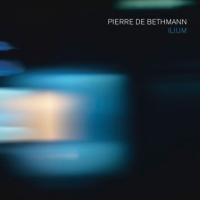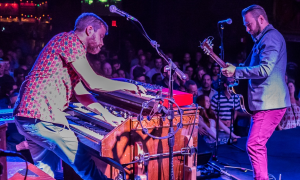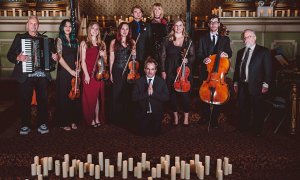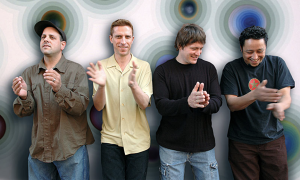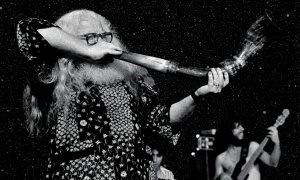Home » Jazz Articles » From the Inside Out » Preludes and Postludes: The Complete Modern Jazz Quartet...
Preludes and Postludes: The Complete Modern Jazz Quartet Prestige & Pablo Recordings
Had he chosen to play a more common jazz or bebop instrument, such as piano or trumpet, Jackson might be rightfully recognized as one of the most consistent, inventive, and personable soloists in jazz history.
 The Complete Modern Jazz Quartet Prestige & Pablo Recordings (Prestige) may seem a curious collection to certain MJQ fans. It’s a bookend compilation, with 54 remastered tracks from their 1952 – ’55 Prestige recordings near the beginning, and from their 1981 – ’85 Pablo recordings near the end, of their 48-year, illustrious and elegant jazz career. Some might think this is not a truly representative MJQ set because it misses the guts of their tenure – their Atlantic Records catalog, most notably the exquisite performance retrospective European Concert (1960) and the chamber funk of Blues on Bach (1973).
The Complete Modern Jazz Quartet Prestige & Pablo Recordings (Prestige) may seem a curious collection to certain MJQ fans. It’s a bookend compilation, with 54 remastered tracks from their 1952 – ’55 Prestige recordings near the beginning, and from their 1981 – ’85 Pablo recordings near the end, of their 48-year, illustrious and elegant jazz career. Some might think this is not a truly representative MJQ set because it misses the guts of their tenure – their Atlantic Records catalog, most notably the exquisite performance retrospective European Concert (1960) and the chamber funk of Blues on Bach (1973).This is factually correct, but it is also wrong. The Complete Prestige/Pablo Recordings does work as a standalone tribute, for two reasons. First, it kindly represents three signature pieces you really must know to know the MJQ: “The Cylinder,” “Django” (the title track of their first full-length recording, composed by Lewis in memory of the famous gypsy guitarist who passed away in 1953), and “Bags’ Groove,” the group’s homage to Milt “Bags” Jackson. Second, it captures the essence of each timeframe it documents, beginning with the MJQ’s genesis in Dizzy Gillespie’s late-1940s big band and ending when the MJQ was a revelatory genre unto itself.
History In Rhythm
The Modern Jazz Quartet was born in the rhythm section of the late-1940s Dizzy Gillespie big band. To give the leading horns a chance to catch their breath during shows, the rhythm section – originally Jackson on vibes, John Lewis (who replaced Thelonious Monk) on piano, Kenny Clarke on bass, and Ray Brown on drums – performed brief sets as a quartet. This configuration recorded as the Milt Jackson Quartet in the early 1950s but by the time these recordings were issued, Percy Heath had replaced Brown, and Clarke was preparing to move to Europe.
 MJQ: Modern Jazz Quartet / Milt Jackson Quartet (1952)
MJQ: Modern Jazz Quartet / Milt Jackson Quartet (1952)
Clarke left and was replaced by Connie Kay. Jackson, Lewis, Heath, and Kay remained THE Modern Jazz Quartet until Jackson’s passing in 1999. They almost instantly discovered a shared musical telepathy that deepened through five decades. This vision exemplified “third stream jazz,” combining jazz harmonic and improvisational techniques with structural techniques from classical music, but also remained true to the soulful, joyous sounds of swing and the blues, like Count Basie.
Lewis is generally considered the group’s “leader” and their classic repertoire consists largely of his compositions. Yet Jackson’s sense of funk and blues is essential to the group’s sound, and had he chosen to play a more common jazz or bebop instrument, such as piano or trumpet, Jackson might be rightfully recognized as one of the most consistent, inventive, and personable soloists in jazz history.
“Softly, As in a Morning Sunrise” marks the dividing line on this Prestige/Pablo anthology. The first version was recorded in 1955 for Concord, and features Lewis traditionally ‘comping behind Jackson’s solo, then studiously soloing like he was composing an essay. This is immediately followed by a version recorded more than a quarter century later, in concert for the Reunion at Budokan 1981 album. As the end of the previous version seamlessly melts into beginning of this one, you realize that it is not only impossible to compare these two versions from a chronological perspective, it is also pointless. This music is timeless.
The Classics
Jackson rings in the familiar funky little blue melody of “Bags’ Groove” as Lewis, completing Jackson’s phrases, rings it out. The second performance is called “Bags’ New Groove” but its liquid sound and rhythm is still classic. Heath steps out front in the break, and when Jackson reenters after Heath’s solo, his tone sounds positively joyous!
“Django” is one of Lewis’ most somber yet beautiful melodies. In the title track of their 1953 album, he supports Jackson with piano chords almost strummed, like a guitar, through seven minutes of sustained musical excellence that deeply and profoundly lays itself to rest. Disc two ends with two concert performances of this tune, with the second swinging just a little more comfortably than the first, especially the harmony and rhythm of Lewis’ piano solo. In “The Cylinder,” Jackson and Lewis precisely dance together and between each other through its intricate melody, which simply yet amazingly winds down to its silent stop. Similarly, Lewis swings through the concert performance of “The Cylinder” more loosely than the original studio version.
 Django (1953)
Django (1953)
Europe & The Blues
Prestige/Pablo flows into the “third stream” with jazz tributes to European classical music, people, and cities. “The Queen’s Fancy” sounds very “old Europe” in its ornate, formal sound and movement. “Sacha’s March” sounds like an eastern European formal dance piece, with Lewis and Jackson providing pomp and circumstance to the affair. “Sacha” is immediately followed by “That Slavic Smile,” a romantic poem written by Lewis for his wife; Jackson mostly plays accompanist here, hanging soft blue figures under whose shade Lewis casts his solo. Both principals sound romantic in two strolls through “Milano,” especially Jackson, whose long, slow, lush and mellow notes suggest Chet Baker.
Through everything, Jackson, Lewis, Heath and Kay never forget the simple joy of swinging the blues. “Ralph’s New Blues” sounds like Basie, especially the economy in Lewis’ piano playing and the irresistible swing of Jackson, who sounds like he will simply never run out of melodic ideas. Basie also echoes through Lewis in the first “Really True Blues,” then he funks up the edges with a gospel, Les McCann feel in his opening and mid-song solo to its second performance.
 Topsy: This One’s for Basie (1985)
Topsy: This One’s for Basie (1985)
In a 1992 interview, Lewis described the Quartet: “We tried to make it a reflection of this country, the ideal reflection that it should be a democracy, where the group takes advantage of the best of the abilities of each of the participants.” This is exemplified by “La Ronde Suite,” Lewis’ four-movement piece which sequentially spotlights himself, then Heath, Jackson, and Kay. But this concept served as the driving force behind their five decades of consistent excellence. As Prestige/Pablo demonstrates, this whole was always greater than the sum of its considerable parts.
Tags
About Modern Jazz Quartet
Instrument: Band / ensemble / orchestra
PREVIOUS / NEXT
Support All About Jazz
 All About Jazz has been a pillar of jazz since 1995, championing it as an art form and, more importantly, supporting the musicians who make it. Our enduring commitment has made "AAJ" one of the most culturally important websites of its kind, read by hundreds of thousands of fans, musicians and industry figures every month.
All About Jazz has been a pillar of jazz since 1995, championing it as an art form and, more importantly, supporting the musicians who make it. Our enduring commitment has made "AAJ" one of the most culturally important websites of its kind, read by hundreds of thousands of fans, musicians and industry figures every month.



